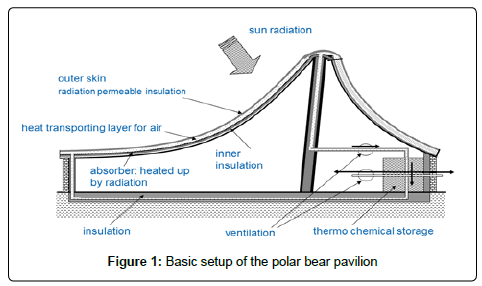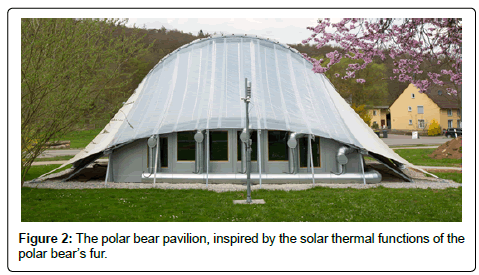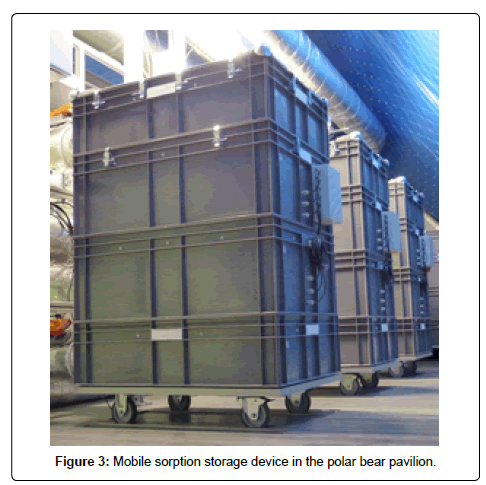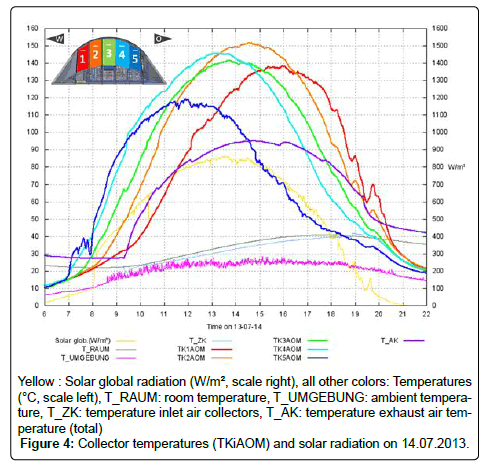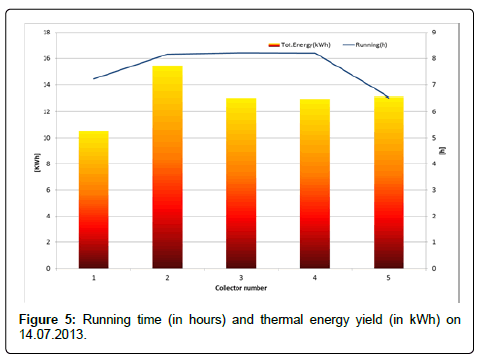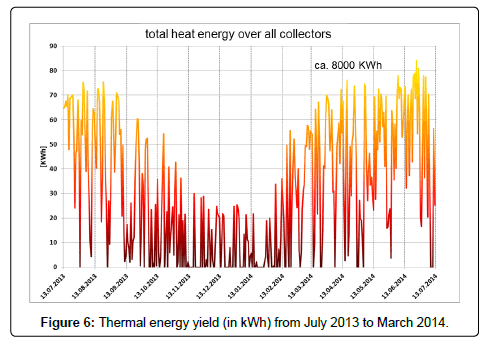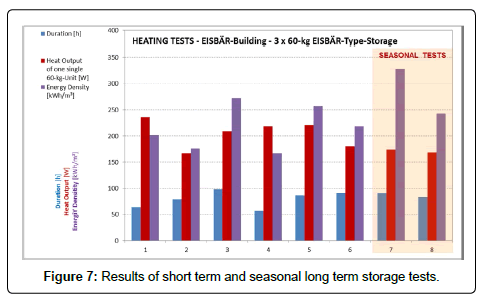Energy-Efficient Textile Building with Transparent Thermal Insulation for the Solar Thermal Use According to the Model of the Polar Bear’s Fur
Received: 13-Sep-2018 / Accepted Date: 25-Sep-2018 / Published Date: 29-Sep-2018 DOI: 10.4172/2576-1463.1000218
Keywords: Energy; Thermal insulation; Solar collector; Textile collector; Textile architecture; Seasonal heat energy storage; Silica gel
Introduction
Today membrane materials, like no other building material, stand for versatile and avant-garde architecture. The intelligent solutions for claddings and roofs (stadiums, airports, air-domes, tents…etc.) are not only appealing and optically extraordinary, but compared to con-ventional buildings they are advantageous. Besides translucency, material efficiency and transportability textile membrane building offers many additional possibilities for lightweight building. Of disadvantage are though its insufficient thermal insulation and energy supply. In order to eliminate this flaw this project was started.
The aim was not only to create a textile building with climatically conditioned interiors, but to realize a method for energy extraction and energy storage. The energy source was focused on sun light, which supply the earth with an average yearly radiation power in Munic with 1.100 W/m² and in the desert Sahara with a maximum of 2.200 kW/h (Figure 1) [1].
Innovation
Textile-based air solar collector
A bionic/biomimetic approach was made based on an analysis of the solar thermal functions of polar bear fur for the development of the textile thermal collector. The dense heat insulating fur with its colorless hair passes a part of the sunlight spectrum on to the black epidermis with its capability to absorb parts of the irradiated solar energy [2]. In interaction an external loss of energy hardly occurs and therefore causes for the effective transformation of solar radiation into thermal energy. The textile cover of the polar bear pavilion follows the following principle: incoming sunlight meets a solar collector that is overflown by air. The air is conducted by a rectangle channel whereas its bottom represents the black absorber. This flexible solar collector is an extremely efficient energy heat exchanger, based on earlier developments at the DITF [3-7]:
The bottom layer is a black coated textile fabric (silicone-coated glass fabric) and creates an absorber that can withstand temperatures up to 180°C (Figure 2).
• On top is the air flowing layer representing the flow device (channel) that is created from an open spacer fabric. This enables a high transparency and in combination this provides flexible solar insulation. The visible light and the near Infrared (NIR) of the sun spectrum can pass while the emission of the longwave light and free convection is reduced.
• An ethylene-tetrafluoroethylene-foil (ETFE) with high transmissivity for the visible light and NIR serves as top-cover.
• Further translucent covering layers increase the thermal insulation and still let the sunlight through.
• The system enables cantilever span width of up to 10 m and curved, freely formable surfaces- a good basis for new architectonic solutions. The polar bear pavilion on the southern side has more than 5 flexible solar thermal collector panels. The therein created warm air is conducted along the roof of the pavilion and is assembled inside the building for heating and storage issues.
Seasonal thermal energy storage
Here is where the second innovation comes in: a long term thermal energy storage system-in contrast to a short term storage system e.g. based on PCM [8]. The energy storage unit is placed inside the building and thermal energy of the heated air can be stored almost without loss. The patented development can balance the energy needs of the building during day/night temperature changes and in summer it can store enough energy to get the pavilion heated through the winter period. The storage medium consists of silica gel that is strongly hygroscopic and shows an extremely large inner surface of about 600 m²/g. When drying (desorption) it absorbs heat which it releases as soon as it is dampened (adsorption). During dampening an increase of the air temperature of about 25°C takes place which then is used for heating using a heat exchanger. The silica gel is suitable for desorption temperatures of about 80-130°C. That implies a maximum load of 25 weight percentage and a maximum value for the adsorption enthalpy of 0.174 kWh/kg. Without any problems the granular material can reach 2.000 charging and discharging cycles. Up to now the energy density in the storage device has reached about 133 kilowatt hours per cubic meter storage content and is therefore already near the theoretical maximum of 165 kWh/m³ (Figure 3).
Textile isolation for low-energy standards
A polyester nonwoven was used for the roof thermal insulation of the polar bear pavilion on the northern side. Also a polyester nonwoven was used on the southern side, underneath the solar collector as it is a temperature-resistant fiber felt. Thus the pavilion exceeds the lowenergy standards and is an unusually energy-efficient membrane building.
The innovative achievement of the research project can be summed up as follows:
• Development of a flexible textile air solar collector with multilayer setup
• Energy extraction in the textile cover
• Extremely high thermal insulation for textile lightweight roof constructions
• Active air conditioning through controlled airflow
• Linkage of solar thermal use with innovative energy storage system
• Demonstration of an energetically self-sufficient textile building.
Results and Implementation
Inspired by the solar thermal functions of the polar bear’s fur in the course of a joint research project the so-called polar bear pavilionan energy-self-sufficient textile membrane building with futuristic architecture was built at the DITF Denkendorf. The pavilion shows an innovative solar thermal system for energy extraction and storage: Flexible solar collectors in the textile cladding in combination with sorption-heat-storage cause for an excellent energy efficiency and make the pavilion energy independent. In Germany on nice summer days, a solar insolation capacity of 800 up to 1000 W/m² is reached through solar radiation. Through heat transfer and energy storage the sunlight is sufficient enough to keep the pavilion warm in summer as in winter. The demonstrational building on the premises of the DITF Denkendorf has a floor space of 121 m². The heat insulated interior comprises 85 m² and at the highest point reaches 5.14 m.
The measured values are subject to a daily, automatic evaluation that e.g. determines then maximum values of the daily solar radiation, the various temperature measurements and volume flow of the collectors. According to the previous results, an air temperature of about 150°C could be reached (Figures 4-6).
Figure 4: Collector temperatures (TKiAOM) and solar radiation on 14.07.2013.
In 2013 and 2014 six measurements (No 1-6) with short periods between the heating and the restoring processes have shown the feasibility of the sorption energy storing and heating capability. In order to proof the seasonal storage capacity two long term measurements had been conducted, Figure 7 shows the measured values (No 7 and 8). In March 2015 a sunny period was used to dry the three storages with together 180 kg of silica gel, which was completely saturated with water during a heating phase some days before.
The stored solar energy was kept in the storages during a period of one year before it was activated and used for a heating cycle in March 2016. After regeneration in April and May 2016 the storages were activated in April 2017 for test No 8. Besides duration and averaged heat output related to one single 60-kg-storage-unit also the magnitudes of the energy density are in very good relation to the short term measurements. The certain value for the evaluation of the long term ability is the energy density.
Even though the value of the 7th test is higher than all other values, the ability is shown due to even or higher values compared to the short term ones. This means, that the energy output after a long and seasonal period is of the same magnitude than after short term periods of storage. The higher value of the 7th test was caused by changing temperatures in the building caused by changing solar impact during the 90 hour heating process. This effect cannot be separated in the evaluation process of the measured data (Table 1).
| Test | Period | Duration [h] | Energy [kWh] | aet output of one single 60-kg-unit [W] | Energy Density [kWh/m3] |
|---|---|---|---|---|---|
| 1 | Marc 2013 | 6403 | 45 | 2358 | 201 |
| 2 | November 2013 | 7900 | 40 | 1671 | 176 |
| 3 | December 2013 | 9800 | 61 | 2084 | 272 |
| 4 | January 2014 | 5725 | 38 | 2192 | 167 |
| 5 | January 2014 | 8725 | 58 | 2210 | 257 |
| 6 | November 2014 | 9128 | 49 | 1799 | 219 |
| 7 | Marc 2016 | 9053 | 59 | 1740 | 328 |
| 8 | April 2017 | 8312 | 55 | 1687 | 243 |
Table 1: Periods and values of the diagram in Figure 7.
The active solar area consists of 5 collector panels (5.4 m length*1,35 m width) of each 7.29 m², in total a sum of 36.5 m. With a maximum perfusion velocity of the thermal solar collectors of 50.7 Nm³/h an efficiency of 51 % was determined.
In view of the energy storage in the first applications drying efficiencies of 70% up to 100% were determined. This means that the supplied thermal energy is absorbed in the storage device to at least 70% (charging efficiency). Trial tests in the laboratory at TAO for the heating efficiency of up to 74% were determined. Additional tests are in progress.
The results give more impulses for textile building: light, translucent buildings can show an energy balance that is sufficient for present and future requirements for resource saving building.
Transdisciplinarity
In the course of this joint research project the project consortium that consists of the DITF Denkendorf (development of the solar thermal collector) and the SME‘s TAO Trans-Atmospheric Operations GmbH (development of the thermal energy storage), TinniT (responsible for the thermodynamic simulation), Labor Blum (set up of measuring devices), Wagner Tragwerke (responsible for construction and static) and Arnold Isolierungen (building, maintenance) has practiced innovations in the enterprises and research through a wellcoordinated transfer of knowledge in both directions. Through this symbiosis the simulation, construction and the experimental tests of the textile “polar bear fur” up to the erection of the demonstrational building in Denkendorf could be encouraged.
Additional support came from the various networks of the single partners. Therewith the radius of action for the provision of information, identification of suppliers and deliveries of materials could be extended. The polar bear pavilion was publicly inaugurated in January 2013 by the Minister of Environment of the State of Baden-Württemberg Mr. Franz Untersteller, in the presence of the press and further guests. During the exhibition of TechTextil in Frankfurt, Germany, 2013 the developments were presented [9,10] and get an award in the area of innovation. The results were discussed in some further conferences [11] and presented in television [12]. In summer 2018 the building was dismounted due to a limited construction permission.
Conclusion
Inspired by the polar bear fur a new concept of a textile solar collect is realized. The flexible collector with a black absorber, black spacer textiles as an efficient energy transformer and highly transparent heat insulation layers achieved an air temperature of 150°C with a solar thermal efficiency of about 51%. The construction of a flexible, tensioned textile roof with this flexible collector was successful demonstrated with the Polar Bear pavilion. For the seasonal storage of the thermal energy from summer to winter time a thermal chemical storage system based on silica gel was developed. The efficiency of loading and discharging of such storage was calculated to 74%. In the combination both technologies worked without problems for 4 years in the demonstration building. The monitored data show repeatable and reliable process technologies.
Acknowledgement
The project was funded by the EU with resources of the European Regional Development Fund (EFRE) and the Ministry of the Environment, Climate Protection and the Energy Sector Baden-Württemberg. We would also like to thank the Project Management Agency Karlsruhe (PTKA-BWP) and the L-Bank for their support.
References
- Ladener H, Late F (1999) Solar systems-Handbook of solar thermal energy use.
- Nightingale (1998) Werner foundations and examples for engineers and scientists. Springer-Verlag Germany.
- Institute of Textile and Process Engineering (ITV) (2005) Development of flexible and extremely economic sun collectors (FLEXCOLL). Final report of the SME/CRAFT European Research Project.
- Stegmaier T, Abele H (2000) Textiles for photovoltaic and solar applications.
- Stegmaier T, Stefanakis J (2007) Solar pioneers are on the trail of the polar bears.
- Stegmaier T, Linke M, Planck H (2007) Textile materials based on bionic principles for solar thermal applications Techtextil. Techtextil Symposium.
- Stegmaier T, Linke M, Planck H (2009) Bionics in textiles: Flexible and translucent thermal insulations for solar thermal applications. Philosophical Transactions of the Royal Society of London A: Mathematical, Physical and Engineering Sciences 367: 1749-1758.
- Pause B (2006) Membranes with thermos-regulating properties for architectural application Adaptables 2006. International conference on Adaptable Building Structures, Eindhoven, The Netherlands.
- Sarsour J, Stegmaier T, Planck H (2013) Solar thermal active membrane construction with an innovative seasonal heat energy storage system.
- Stegmaier T, Sarsour J, Gresser GT (2013) Solar thermal building with seasonal heat storage system. VI international conference on textile composites and inflatable structures- Structural Membranes.
- Sarsour J, Stegmaier T (2014) Energetic considerations on solar thermal textile material systems Symposium. Coating of technical textiles.
- Stegmaier T, Sarsour J, Gresser GT (2014) Eisbärpavillon, TV Beitrag in Galileo.
Citation: Stegmaier T, Sarsour J, Gresser GT, Wagner R, Kröplin B, et al. (2018) Energy-Efficient Textile Building with Transparent Thermal Insulation for the Solar Thermal Use According to the Model of the Polar Bear’s Fur. Innov Ener Res 7: 218. DOI: 10.4172/2576-1463.1000218
Copyright: © 2018 Stegmaier T, et al. This is an open-access article distributed under the terms of the Creative Commons Attribution License, which permits unrestricted use, distribution, and reproduction in any medium, provided the original author and source are credited.
Select your language of interest to view the total content in your interested language
Share This Article
Recommended Journals
Open Access Journals
Article Tools
Article Usage
- Total views: 5383
- [From(publication date): 0-2018 - Dec 21, 2025]
- Breakdown by view type
- HTML page views: 4458
- PDF downloads: 925

